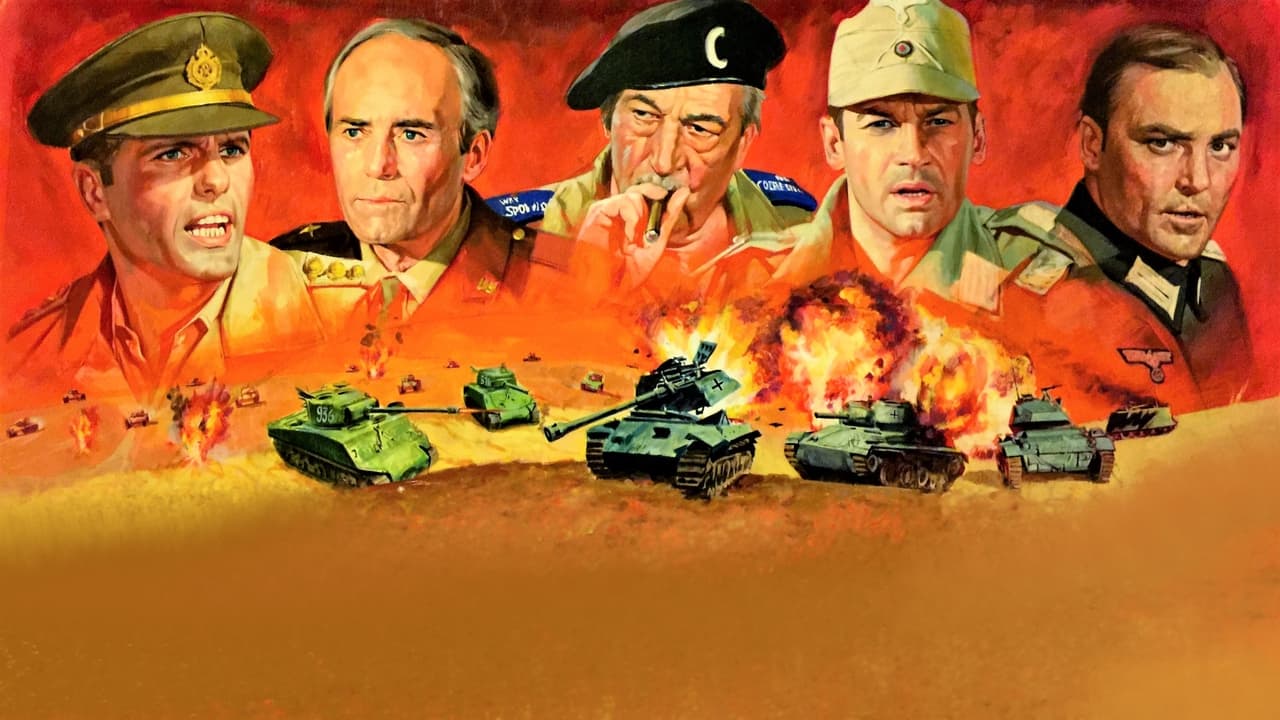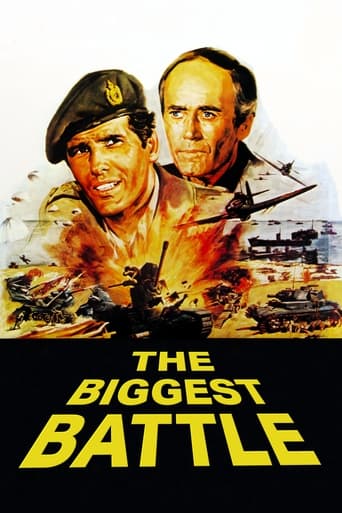


terrible... so disappointed.
... View MorePlot so thin, it passes unnoticed.
... View MoreJust perfect...
... View Moren my opinion it was a great movie with some interesting elements, even though having some plot holes and the ending probably was just too messy and crammed together, but still fun to watch and not your casual movie that is similar to all other ones.
... View MoreThe Biggest Battle (1978) * 1/2 (out of 4)Incredibly disappointing drama starts off in Germany during the 1936 Olympics where an American general (Henry Fonda), a German major (Stacy Keach), a Jewish actress (Samantha Eggar) and a war correspondent (John Huston) are having dinner and agreeing that Hitler will not cause a war. Flash forward to 1942 and war is happening and all sides of this dinner are now in the middle.THE BIGGEST BATTLE is an Italian and West German co-production that was meant to rival various American movies that took on the WWII subject. Of course something like MIDWAY was an obvious inspiration. The most interesting thing about this film is that it did have a bigger budget than you'd normally see in a film like this but the problem is that the budget wasn't big enough. It's clear that writer-director Umberto Lenzi wanted to make an epic war film and even got a terrific cast together but the film falls well short of that.There's no question that the biggest problem with this film is its screenplay. I never found any of these characters to be interesting and especially the Keach character. I found the character to be extremely bland but so was another subplot that deals with Fonda and his two sons going off to fight in the war. The "proud father" aspect just doesn't work. There's really nothing story wise that connects with the viewer and this incldues the action. There are a lot of action scenes but they just feel cheap and never contain any tension.With all of that being said, the most amazing thing about this picture is the fact that they got such a great cast. You've got Fonda, Keach, Huston and Eggar but there's also Helmut Berger, Edwige Fenech, Ray Lovelock and various other foreign actors. You've also got Orson Welles doing the narration in some versions but the version I watched didn't feature that. The story was confusing as it was so perhaps his narration was used to make more sense out of the film?THE BIGGEST BATTLE is a pretty poor film but the worst thing is the fact that it's really disappointing considering the cast.
... View MoreIl grande attacco, also known in various versions under the English titles Battle Force and The Greatest Battle, is by consensus a muddled WW2 Action picture with some good battle scenes and a confused plot. It maybe that the film is a lazy effort on the part of its writers but it also, in its incoherence, manages to say something about war and history which is inexpressible through a more formally consistent narrative.A disparate group of people – an American general (Henry Fonda), an Irish-American war correspondent (John Huston), a German officer (Stacey Keach) and a famous German-Jewish actress (Samantha Eggar) meet in Berlin on the day that Jessie Owens wins an Olympic gold medal and the German chancellor, Adolf Hitler, refuses to shake the athlete's hand. The characters gossip casually about this and go their separate ways, with Fonda and Keach swapping souvenir Olympic medallions as a measure of their friendship. Six years later, these and a number of other characters are enmeshed in the second world war, the film consisting of various seemingly random sequences involving the characters in some kind of dramatic situation or undertaking a battle mission. Some of them are killed and some are still alive in 1943, where the film arbitrarily ends. But a coincidence means that the now dead Keach's medallion is in the hands of Fonda's American hero son (Ray Lovelock, of Living Dead at the Manchester Morgue 'fame').Taking the film at face value and allowing it not to conform to classical narrative structures, it seems that the arbitrary and the coincidental are the rules of the game here. There is no narrative arc or learning curve to most of the characters' lives; they are driven to undertake their roles in the war, through either loyalty to their homeland or to their professions, without even really coming to a consciousness of their situation. This is most striking in Keach's story: he marries Eggar and fights and dies, heroically, for the German side in Africa; at home, his wife is sexually harassed and persecuted by the Gestapo until she commits suicide. Keach dies without knowing that the ideology he has been fighting for has killed the woman he loves.Another sub-plot features Edwige Fenech as a French woman driven to prostituting herself to German officers by poverty. She isn't a bad person, she's eaten with self-loathing through her circumstance and is genuinely shocked when the Germans execute a Resistance fighter who has tried to hide in her apartment. Nevertheless, she herself is shot dead by the Resistance who are under the misguided impression that she was behind their compatriot's death. Her murder is quick and brutally achieved and her death doesn't teaches anyone anything. Life in war, for her and for most of the characters, is meaningless, degrading, dangerous and comes to a sudden end, as if life were a drive which simply stops when it meets an opposing, amoral force. Earlier in the film, Fenech has been helped by German officer Helmut Berger, here playing a character somewhat similar to Brando's in The Young Lions. Berger is fiercely loyal to Germany but doesn't seem ideologically Nazi nor does he seem to have lost his humanity – he looks seriously disturbed as he sees the death around him. Yet like Keach he never learns anything but how to die, which he (like an American soldier he'd previously shot) begs for. That Fonda's son doesn't kill Berger at the latter's request means nothing, as Berger croaks whilst drinking the water that Lovelock tries to force down his throat.There is a brief respite from the film's grimness at the end, as Fonda learns that Lovelock has survived thus far and been commended. Yet this is a bitter sweet given that this takes place after Fonda's visit to his other son's grave, who has been killed a few months before. More telling is the moment where Huston and a young cameraman are killed filming a battle – the camera is shown strewn in the sand, as if in a reflexive moment Il grande attacco realises and admits that the process of filming battles is futile.There's no point in arguing that this is a great film. There is something rather distasteful about its predominant concentration on the lives of the officer classes (Fenech's character is the only exception) and it may be that Il grande attacco really is not worthy of serious consideration. Yet its inconsistency and randomness adds up to a curiously consistent vision of war as a meaningless serious of events for those unlucky enough to be caught up in its history and unconscious enough not to comprehend their predicament. Director and co-writer Umberto Lenzi was, during the same period as this film was produced, producing some of the sleaziest and sickest of the giallo, crime and even cannibal films of the age; perhaps this is better understood as part of that movement in Italian cinema that produced films which deliberately undercut the meaning-making inherent in the Hollywood model, producing a provoking vision of a universe of cruelty, absurdity and violent death which shows that the world is more made up of swirling, futile vortices than character-building, consequential journeys.
... View MoreI don't understand how Luciano Martino and Mino Loy were able to raise the money to hire so many big-name actors of the time (such as Orson Welles, John Huston, Henry Fonda, and Samantha Eggar) but they still had to rely on plentiful stock footage from earlier war movies like THE BATTLE OF EL ALAMEIN and LEGION OF THE DAMNED. Umberto Lenzi's directing is good as usual, with lots of emphasis placed on the well-edited action scenes. The budget for such scenes seems quite minimal however, with a lot of the same actors dying over and over again, and a few really shoddy toy tanks exploding (though a few shots of these tanks were lifted from other movies).As for the cast, just about everybody that had anything to do with the Italian movie industry shows up somewhere in the movie, from familiar dubbing voice Robert Spafford as Patton to future director Michele Soavi as Fonda's dead son. The photography and music are all top notch, yet this movie has gotten ad reviews accross the board. Why? Because it has little or no plot to speak of. There are so many characters and so much going on in the film that it has no focus or direction. Eggar's character has no point in the movie other than she makes it slightly longer, and Edwige Fenech gets one lousy scene as a French prostitute. Eventually, most of the actors end up in Africa fighting on one side or the other and (surprise!) the Germans lose and all the German characters die, the end. But who goes to watch a good old-fashioned war movie for the plot anyway? There's plenty to enjoy if you like watching German soldiers lying in the road pretending to be dead so they can shoot the American soldiers that run up to help them. It also contains a number of memorable scenes like when Stacy Keach gets lost in the desert and falls over after about 1 minute of walking, and a very goofy case of bad communication when Ray Lovelock attempts to call up his father and the two barely manage to get through even a few words...The ending really comes out of nowhere though, but it's made especially funny as John Huston seems to just get bored of the movie and walk off saying "seeya around" right into the camera! Definitely not a movie to miss...for fans of the genre.
... View MoreFor a low-budget movie set during World War II, it does have a rough and violent edge. Above all, BATTLE FORCE surrenders to a non-existent plot and storyline that's been duped hundreds of times repeatedly. Don't expect much here as there's no specific meaning. Explosions and body counts are nothing new! Adding to the troop casulty count is of Orson Welles' annoying and interrupting narration, making it feel like a made-for-television documentary. War movies are instant classics in the grade "A" Hollywood circuit, and SAVING PRIVATE RYAN triumphs realism today. Despite a fairly good replica of those WW2 days, BATTLE FORCE is another run-of-the-mill production without enough substance. Anyone who grew up watching Hollywood war dramas in their lifetimes probably avoided this one while history was made.
... View More